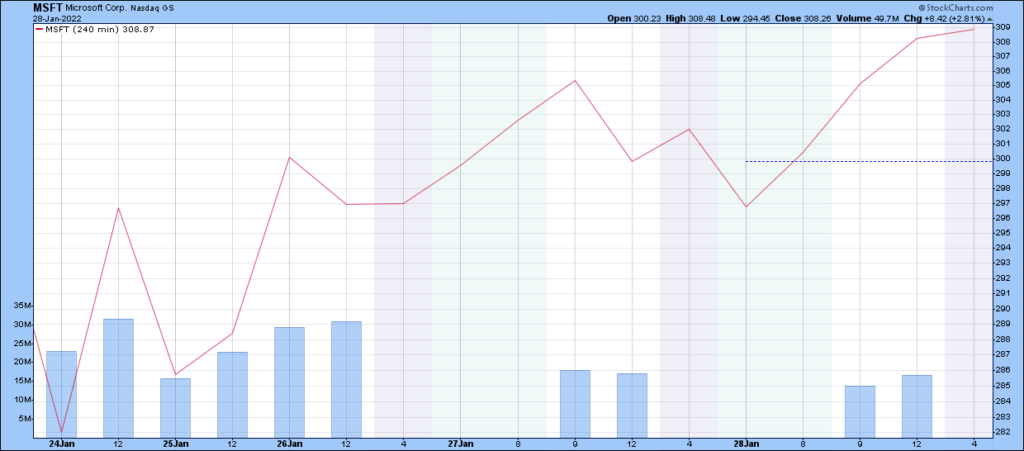In the midst of this week’s market convulsions, Microsoft (NYSE: MSFT) released its FY22 Q2 results for the quarter ending December 31st, 2021. In the hysteria of the after-hours trading session, the initial market reaction was negative, with shares sliding 5% in what was perhaps due to an up-tick in operating expenses. However, taken in its entirety, with both a top and bottom-line beat, and the company issuing exceedingly positive guidance on the subsequent earnings call, the slide was followed by a quick reversal, trading up 2%.
Here’s a closer look at the high-level (adjusted) numbers.
- Revenue $51.7 billion, increased 20%
- Operating income $22.2 billion, increased 24%
- Net income $18.8 billion, increased 21%
- Diluted earnings per share $2.48, increased 22%
By almost any rational measure, it’s nothing short of a great quarter.
But, in a similar way to what I wrote about last week regarding Goldman Sachs earnings, the interesting trend, and in my opinion, the most relevant one, comes from the broken-out, top-line revenue numbers and growth rates of Microsoft’s three main business lines: Intelligent Cloud, Productivity and Business Processes, and Personal Computing. The three segments’ revenue contributions were $18.3B, $15.9B, and $17.4B respectively.
As for the YOY growth rates, the Personal Computing segment grew 15%. This in large part from what Microsoft CEO, Satya Nadella calls a “structural shift in PC demand” resulting from new hybrid work preferences. The higher demand manifested itself in greater PC usage (hours per day) and more PCs per household.
Productivity and Business Processes, which includes Office 365, Dynamics 365, Microsoft Teams, Linkedin and Skype, grew 19%.
But it was the Intelligent Cloud segment and Microsoft Cloud (aggregate services) that stole the show.
Intelligent Cloud printed a whopping 26% revenue increase compared to the same quarter last year. The segment consists of public, private, and hybrid server products Azure, Azure Arc, and GitHub.
Azure alone grew 46%, and per Microsoft CFO, Amy Hood, Azure is also the primary driver for the positive guide to sequential Q3 growth.
But alas, it was Microsoft Cloud that took pride of place among all the headline numbers. It printed revenue of $22.1B and YOY growth of 32%.
 Microsoft – Cloud – Software & Fintech Investment Bank
Microsoft – Cloud – Software & Fintech Investment Bank
Note: If you didn’t pick it up already, there’s an interesting nuance to the way Microsoft characterizes cloud-based revenues (which explains the delta between *Intelligent Cloud* revenue and *Microsoft Cloud* revenue). Although Intelligent Cloud is the name of the official business line, Microsoft Cloud captures additional cloud revenues from Productivity and Business Processes and Personal Computing, including Office 365 Commercial, Dynamics 365, and the ‘commercial’ portion of Linkedin.
Investment bank take…Microsoft’s (wonderfully) cloudy forecast.
If one was handed Nadella’s portion of the earning’s call transcript ‘cold’, you would be forgiven for thinking you were reading a half-baked, science fiction story set 20-years in the future.
Microsoft’s cloud-based products and services are responding to, and accommodating demand from, an expansive cross-section of economic consumption, including governments, IT communication giants, all-flavor of enterprises, SMEs, and individual consumers. And much of the cloud-based products and services, beyond the more ‘basic’ computational infrastructure offerings, are the poster-children for the most advanced and innovative technologies being deployed in today’s economy.
I mean really cutting-edge technologies.
For example, in the realm of application development, Microsoft’s Azure IoT, Digital Twins, and Mesh are providing the infrastructure for the metaverse. While ‘the Zuck’ and Facebook are grabbing headlines over the brouhaha for changing its name to Meta, Microsoft’s cloud-services are delivering theimmersive simulation technologies that actually constitute the metaverse – augmented reality, virtual reality, and mixed reality.
And in the area of broader information technology, some of the largest communication companies – AT&T for instance – are leveraging their new 5G networks with Azure to accelerate the development of edge computing infrastructure, which will be needed to unlock the true potential of the Internet of Things, alongside advanced machine learning AI, and, believe it or not, blockchain.
It’s likely that at some point in the future we will all look back and recall Nadella’s opening statement on this earnings call.
“We’re living through a generational shift in our economy and society. Digital technology is the most malleable resource at the world’s disposal to overcome constraints and reimagine everyday work and life”
The statement is as observationally astute as it is inspiring and will (at least I believe) receive a lot of play in the years to come.
But it was his next statement that really jumped out at me.
“As every company becomes a digital company, they will [all] need a distributed computing fabric to build, manage, secure and deploy applications anywhere.”
Think about that for a second.
Every company.
Will be a digital company.
Will need a distributed computing fabric.
The comment is deafeningly profound in its predictive character. Especially in its allusion to the cloud as being the foundational technology for the future.
…and that does make Microsoft’s cloudy forecast truly wonderful.